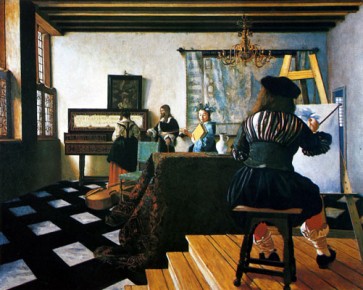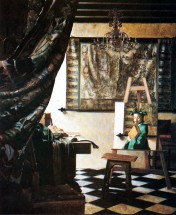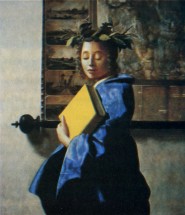Vermeer Interior
| Date: | 1976
|
| Medium: | Oil on canvas |
| Size inches: | c. 28 1/4 x 35 3/4 |
| Size cm: | 72 x 91
|
| Signature: | Probably signed on the reverse |
| |
| Location: | Robert H. Orchard Collection, St. Louis, Missouri |
In (a) painting based onThe Art of PaintingtitledEasel Painting(1976), Deem moves Vermeer's subject ahead in time. InEasel Painting, the artist and model have left the studio, leaving the completed painting displayed prominently on its easel, positioned within the precise room environment established by Vermeer. In another painting from the same year titledVermeer Interior, Deem reconceptualizesThe Artof Paintingwithin the context of Vermeer'sThe Music Lesson. To create this work, Deem widens the space of the room, adjusts the lighting, moves the figure of the artist closer to the viewer, and creates a platform on which he can be placed so that his same posture and position is maintained. In bothEasel PaintingandVermeer Interior, Deem conveys much of the essential character of Vermeer -- his choice of palette, calculated compositional design, and attention to natural light -- yet through his combinations and extensions of original Vermeer ideas Deem asserts a new dynamic that is all his own. (Marguerite Anne Glass,Vermeer In Dialogue: From Appropriation ToResponse, PhD Dissertation, 2003, Department of American Studies, University of Maryland
drum.lib.umd.edu/bitstream/1903/45/1/dissertation.pdf
May 1976 (artist's date of painting).
(
Vermeer Interior,
Easel Painting,
New Vermeer). These pictures were composed as a series, there is a progression from 1 to 2 to 3. The reference or starting point for this series is
Vermeer's Artist in His Studio (in the Vienna Kunsthistorisches Museum).
1. Vermeer Interior. The title is descriptive. The picture deals with Vermeer's
atmosphere for a working painter -- the studio props and set-ups, everything from his light source to still-life objects to the live model. I depart from Vermeer in my treatment of these things. And I depart from Vermeer in the
position we each assign to the painter. Vermeer in the seventeenth century naturally respected the proscenium. That is to say he consistently puts everything in a picture
behind the picture plane. So in his picture
Artist in His Studio he places the painter
in the same constructed pictorial space as the model and other studio furniture. In my picture
Vermeer Interior I place the painter on his own wooden platform, out in front of the picture. He is able to move across the flat surface to any painting position he chooses. He is free to work if he likes with any of the painting situations in Vermeer's space (room, studio, interior) but because he is
outside Vermeer's space he is on his own as regards perspective, light, weight, color, etc.
2.
Easel Painting. In Vermeer's
Artist in His Studio, "the painter is seated on a low stool and is painting on a canvas with a grey ground and slightly inclined, on which we can see a light preliminary sketch." In my picture
Easel Painting the "light preliminary sketch" has been brought to a finished picture and there is no need any longer for either the artist or the model. They have left the studio. The completed picture is on the easel and ready to begin its own independent existence. The painter's connection with his picture stops at this point. And it is here at this point that I make that identification with Vermeer that you mention in your letter. You wrote that you felt "the third painting practically is an identification with Vermeer." But actually it is in this picture,
Easel Painting, that I make the identification of the two painters --seventeenth century and twentieth century. Because at this point the picture on the easel is completed and it is now possible to make my statement about the relationship between between pictures as visual images having their own existence in the mind. My picture is a continuation of Vermeer's picture. It is an extension of his image, or a completion of it in another. This picture also is making another statement -- about the continuing life of easel painting.
3.
New Vermeer. THIS is the painting that is visible on the easel in
Easel Painting. (During the making of the picture the artist decided to have the model in Vermeer's
Artist in His Studio drop her right hand and the trumpet she held in it, and in his picture she has become a standing figure alone in front of her map). In Vermeer's
Artist in His Studio the picture on the easel was "a light premiminary sketch." In my first picture in this series,
Vermeer Interior, the painting that is seen on the easel over the artist's shoulder is also just begun, "a light preliminary sketch." It is the only article in my picture that is painted in black and white. In my second picture in this series,
Easel Painting, the picture on the easel is a completed painting. In my third picture in this series,
New Vermeer, the completed picture has been taken off the easel and is actually here --
New Vermeer. (In answer to your question, No I did not change Vermeer's signature on the map in this picture -- it is copied exactly from the signature on the map in Vermeer's original picture,
Artist in His Studio). (George Deem, letter to Udo Kultermann, September 20, 1976).
(In Vermeer Interior) in the final full coats of glazing I used Damar varnish and linseed oil, cut with turpentine, to apply alternately raw sienna and thalo blue. My white was titanium white. (Letter June 29, 1976, from George Deem, Cortona, to Robert H. Orchard, St. Louis, Missouri).



